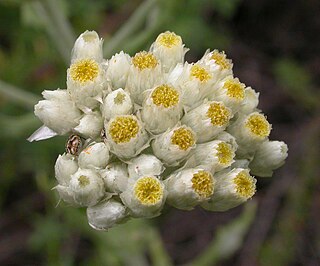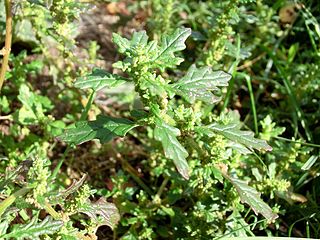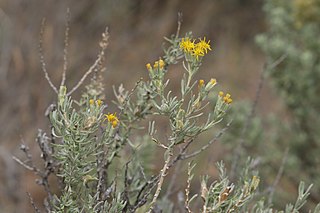
Chenopodium is a genus of numerous species of perennial or annual herbaceous flowering plants known as the goosefoots, which occur almost anywhere in the world. It is placed in the family Amaranthaceae in the APG II system; older classification systems, notably the widely used Cronquist system, separate it and its relatives as Chenopodiaceae, but this leaves the rest of the Amaranthaceae polyphyletic. However, among the Amaranthaceae, the genus Chenopodium is the namesake member of the subfamily Chenopodioideae.

Salvia columbariae is an annual plant that is commonly called chia, chia sage, golden chia, or desert chia, because its seeds are used in the same way as those of Salvia hispanica (chia). It grows in California, Nevada, Utah, Arizona, New Mexico, Sonora, and Baja California, and was an important food for Native Americans. Some native names include pashiiy from Tongva and it'epeš from Ventureño.

Chenopodiastrum murale, is a species of plant in the family Amaranthaceae known by the common names nettle-leaved goosefoot, Australian-spinach, salt-green, and sowbane. This plant is native to Europe and parts of Asia and northern Africa, but it is widespread worldwide, particularly in tropical and subtropical areas due to the ease of it being introduced. It is a common weed of fields and roadsides.

Pseudognaphalium californicum is a species of flowering plant in the daisy family known by several common names, including ladies' tobacco, California rabbit tobacco, California cudweed, and California everlasting.

Sambucus racemosa is a species of elderberry known by the common names red elderberry and red-berried elder.

Blitum virgatum, is a species of flowering plant in the amaranth family known by the common name leafy goosefoot. It is native to Eurasia. It can be found on other continents as an introduced species, growing as a minor weed in disturbed habitats and cultivated land.

Chenopodium atrovirens is a species of flowering plant in the amaranth family known by the common names pinyon goosefoot and dark goosefoot.

Oxybasis chenopodioides, is a species of flowering plant in the family Amaranthaceae known by the common name low goosefoot.
Chenopodium desiccatum is a species of flowering plant in the family Amaranthaceae known by the common names aridland goosefoot and slimleaf goosefoot.

Chenopodium fremontii is a species of flowering plant in the family Amaranthaceae known by the common name Frémont's goosefoot. Both the species' specific epithet, and the common name derive from the 19th century western pioneer John C. Frémont.
Chenopodium hians is a species of flowering plant in the family Amaranthaceae known by the common names hians goosefoot and gaping goosefoot. The Latin species name hians means "gaping".

Chenopodium pratericola is a species of flowering plant in the goosefoot family known by the common name desert goosefoot. It is native to much of western and central North America, where it grows in many types of open habitat, such as sagebrush, often on alkaline soils.

Dysphania pumilio is a species of flowering plant in the family Amaranthaceae known by the common name clammy goosefoot.

Blitum nuttallianum, is a species of flowering plant in the amaranth family known by the common names povertyweed and Nuttall's povertyweed. It is native to North America, where it is widespread and common from Alaska to Mexico to New England. It can be found in many types of habitat, including disturbed areas, often favoring wet places. It is a fleshy annual herb producing two or more erect, reddish, hairless stems up to about 40 centimeters tall. The thick lance-shaped or arrowhead-shaped leaves are up to 4 centimeters in length. Clusters of several rounded flowers each appear in the leaf axils and yield small fruits about 2 millimeters wide.
Nama californicum is a species of flowering plant in the borage family known by the common name California fiddleleaf. It is native to much of California and parts of western Nevada, where it grows in several types of dry and sandy habitat in desert, mountain, and valley areas.

Polemonium californicum is a species of flowering plant in the phlox family known by the common names moving polemonium, low Jacob's-ladder, and California Jacob's ladder. It is native to the northwestern United States, where it grows in shady and moist habitat, such as mountain woodlands. It is a hairy, glandular rhizomatous perennial herb forming clumps of several decumbent to erect stems 30 to 50 centimeters in maximum height. The leaves are up to 20 centimeters long and are compound, made up of several pairs of oval to lance-shaped leaflets. The leaflet at the tip of the leaf is often fused to the pair behind it. The inflorescence is a crowded cluster of bell-shaped flowers each up to 1.5 centimeters wide. The flower is blue or purple with a yellow center and a whitish tubular throat. The fruit is a capsule.

Pycnanthemum californicum is a species of flowering plant in the mint family known by the common name Sierra mint, mountain mint,, and California mint.

Tetradymia argyraea is a species of flowering plant in the aster family known by the common names spineless horsebrush and gray horsebrush. It is native to western North America.

Blitum is a genus of flowering plants in the amaranth family Amaranthaceae, subfamily Chenopodioideae. It is closely related to genus Spinacia. Its 12 species were traditionally placed in the genera Chenopodium, Monolepis, or Scleroblitum. The species of genus Blitum occur in Asia, Europe, North Africa, the Americas, and Australia.

Bassia hyssopifolia is a species of flowering plant in the family Amaranthaceae, known by the common names five-horn smotherweed, five-hook bassia, and thorn orache. It is native to parts of Asia and Eastern Europe, and it is known on other continents as an introduced species, including North and South America and Australia. It is a weed, invasive at times.

















